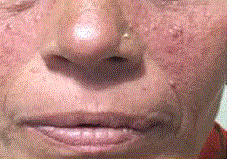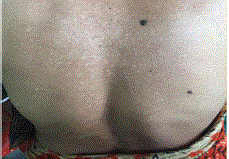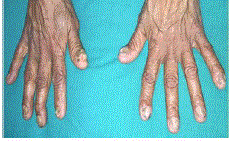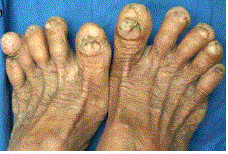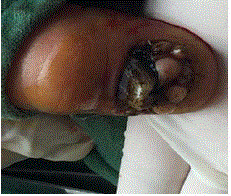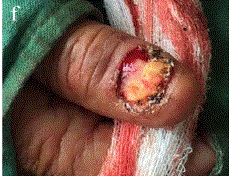Case Report
Koenen Tumors 20 Nail Involvement: A Rare Case Report
Aryal E*, Bastakoti S, Bhatarria S, Shrestha SB and Pokhrel G
Department of Dermatology, Kathmandu University School of Medical Sciences, Nepal
*Corresponding author: Rajouria EA, Department of Dermatology, Kathmandu University School of Medical Sciences, Dhulikhel Hospital- Kathmandu University Hospital, Dhulikhel, Nepal
Published: 08 Aug, 2017
Cite this article as: Aryal E, Bastakoti S, Bhatarria S,
Shrestha SB, Pokhrel G. Koenen
Tumors 20 Nail Involvement: A Rare
Case Report. Ann Clin Case Rep. 2017;
2: 1411.
Abstract
Introduction: Tuberous Sclerosis Complex (TSC) is a multisystem disorder characterized by growth of benign tumors in various organs of the body, caused by mutations of TSC1 or TSC2 gene.
Periungual fibromas are a common cutaneous manifestation and a frequent source of cosmetic and
functional concern. The purpose of this paper is to report a rare case of Koenen tumours with 20
nail involvement.
Case Report: A housewife aged 55 years presented with complaint of difficulty in doing regular
household work due to periungal growths on both hands. She had history of 2-3 episodes of seizures
during childhood. Physical examination revealed firm, smooth, skin coloured periungal growths in
all 20 nails suggesting ‘Koenen tumors’. Multiple facial angiofibromas and ash leaf macules on the
back, were seen. We diagnosed the case as TSC on the basis of above findings which fulfilled three
major diagnostic criterias. Koenen tumors of bilateral thumbs were ablated by CO2 laser.
Discussion: TSC is a lifelong condition. Symptoms may cause disfigurement and disability, as in
this case. So, early diagnosis and regular monitoring is very essential. Till date, a case of Koenen
tumors involving 20 nails has not been reported from Nepal.
Keywords: Tubereous sclerosis complex; Koenen tumors; 20 Nail
Introduction
Tuberous Sclerosis (TS) is an autosomal dominant, neurocutaneous syndrome along with
multisystem, characterized by growth of benign tumors in various organs such as heart, kidney,
central nervous system along with face and nail resulting as Tubereous Sclerosis Complex (TSC)
[1]. TSC is caused by mutation on either of two genes; encode for the proteins hamartin TSC1 and encoding tuberin TSC2 respectively. These proteins act as tumors growth suppressor agents that
regulate cell proliferation and differentiation [2].
Tuberous sclerosis complex (TSC) or Bourneville’s disease, first described by Desiree-Magloire
Bourneville in 1880, and the Neurologist Vogt in 1908 established a diagnostic traid of epilepsy,
idiocy and adenoma sebaceum.TSC occur in all races and ethnic groups and in both gender. The
live birth prevalence is estimated to be between 10 and 16 cases per 100,000 [3]. TSC is diagnosed when either 2 major features (out of a total of 11) or one major feature with 2 minor feature (out of
total 9) are present [4].
Peri-Ungual fibroma known as Koenen tumor is one of the major criteria and observed in 20 %
of patients of TSC. They are usually asymptomatic, but sometimes cause nail deformity and pain.
The purpose of this paper is to report a rare case of Koenen tumors with 20 nail involvement.
Case Presentation
A 55 years housewife present with chief complaint of difficulty in doing regular household work due to periungal growths on both hands specially while peeling of maize. These periungal growth were gradual onset since puberty and were asymptomatic, gradually with time it were present in all twenty nail and especially on bilateral thumb, the growth became more enlarge and painful which restricted her for doing household works. She had history of 2 episodes of seizures during childhood, but was not treated and was not taking any medication. Multiple, tiny, reddish non tender, asymptomatic bums were present in her face since childhood along with multiple hypopigmented, asymptomatic patch on her back. She had got good and happy married life with two sons and three daughters with normal and healthy grand childrens. Psychological assessment and Intelligence quotient (IQ) was equally efficient when compared with other ladies of similar age. On Examination of patient revealed multiple dome shaped reddish to brown papular lesion less than 0.5 cm over nasolabial fold and cheeks suggestive of facial angiofibromas(adenoma sebaceum) in a typical butterfly pattern (Figure 1). There were multiple hypo pigmented ‘ash leaf macules’ on the back (Figure 2). Multiple firm, smooth, skin colored to mild reddish periungal non tender verrucous growths were seen on the surface in all 20 nails suggesting of ‘Koenen tumours’ (Figure 3,4 and 5). All the nails were dystrophic. Her family history was negative for TSC. Examination of her eyes (fundoscopy) and cardiovascular and CNS,were in normal limits. Abdominal ultrasound imaging, X- ray of hand and feet were also normal. CT scan and MRI were not significant. Blood investigation for complete blood count, liver function test, Renal function test, within normal limits .The diagnosis of TSC was made on with clinical ground fulfilled with three major criteria, without the requirement of histological confirmation. Koenen tumours of bilateral thumbs were ablated by CO2 laser under aseptic condition (Figure 6). Our case was uncommon as the tumors affecting all fingers and toe nails along with healthy neurological feature at age of fifty.
Figure 1
Figure 2
Figure 3
Figure 4
Figure 5
Figure 6
Discussion
Tuberous sclerosis complex is autosomal disorder characterized
by multiple hamatomas of skin, kidney, retina, heart and central
nervous system [1]. Only 25% of patients present with classical triad of disease. The incidence of disease is 1/10,000 and up to 50%
of cases result of spontaneous mutation [1]. The diagnosis of TSC
can be made by genetic analysis or on the basis of clinical diagnostic
criteria as given below (Table 1). Half of the TSC families are linked
to chromosome 9q34 with tumor suppressor activity protein tuberin
(TSC1) and the other half to chromosome 16p13 with tumor
suppressor activity protein hamartin (TSC2) [1].
Koenen tumors are periungual or subungual fibromas appearing
as reddish to flesh-colored, smooth, soft to firm papules and nodules
emerging from nail folds. They are usually 5–10 mm in length, but
may be very large. This can be the only clinically evident abnormality
[5-6]. In 50% cases of TSC, it appears at an age between 12 and 14
years and increases progressively in size and number with age. The
tumors sometimes become hyperkeratotic, resembling fibrokeratoma
[7]. Similar case of multiple periunugal verrucose nail was reported
from India [6]. Histologically, Koenen tumors are characterized
by fibrosis with stellate shaped strands of fibroblasts and dense collagen with numerous ectatic blood vessels. Multiple Koenen tumors, affecting all the fingers and toe nails, with a bigger size and
morphologically resembling periungual wart, have been reported
earlier [7,8]. Periungual fibromas are frequent source of cosmetic and
functional concern, and were treated with a continuous wave CO2
laser in sequential focused and defocused modes at 10-15 Watt. As
compared to conventional surgery in terms of cosmetic satisfaction,
CO2 laser presents a viable alternative to surgery through significantly
reduced treatment time and amount of bleeding and wounds healed
well with good cosmetic results. Berlin in 2002 as got good cosmetic
result case with CO2 laser [9]. It is an underestimated figure as
many cases of TSC remain undiagnosed due to various clinical
presentations. Intervention programs, including special schooling
and occupational therapy may benefit individuals with special needs
and developmental issues [5] laser treatment surgery; dermabrasion
may be useful for treatment of skin lesions. Prognosis of the disease
depends on the severity or multiplicity of organ involvement. About
a quarter of severely affected infants are thought to die before age 10
years, and 75% die before age 25 years old [5]. However, the prognosis
for the individual diagnosed late in life with few cutaneous signs as
present in our case, where she present at age of 56 with difficulty for
doing her normal household work due to periungual fibroma, without
any clinical presentation of neurological and systemic feature.
Conclusion
TSC is a lifelong condition; therefore individuals should be regularly monitored by an experienced clinician. It is not uncommon for patients with TSC to have symptoms or signs that do not lead to immediate diagnosis. In some cases, diagnosis is delayed for prolonged periods of time. Early diagnosis is important to improve quality of life, and to avoid disfigurement and disability.
References
- Inoki K, Guan KL. Tuberous sclerosis complex, implication from a rare genetic disease to common cancer treatment. Hum Mol Genet. 2009; 18: R94-R100.
- Leung AK, Robson WL. Tuberous sclerosis complex: a review. J Pediatr Health Care. 2007; 21: 108-114.
- Syed KN. Tuberous sclerosis. J Pak Med Assoc. 2010; 60: 683-685.
- Roach ES, Sparagana SP. Diagnosis of tuberous sclerosis complex. J Child Neurol. 2004; 19: 643-649.
- Kishore R, Chakma K. Tuberous Sclerosis in a Young Female- A Rare Case Report IOSR. Journal of Dental and Medical Sciences. 2015; 14: 58-61.
- Devi B, Dash M, Behera B, Puhan MR. Multiple koenen tumors: an uncommon presentation. Indian J Dermatol. 2011; 56: 773-775.
- Baran R, Richert B. Common nail tumors. Dermatol Clin. 2006; 24: 297-311.
- Thami GP, Kanwar AJ. Acquired periungual fibrokeratoma resembling koenen tumour. Indian J Dermatol. 1999; 44: 78-79.
- Berlin AL, Billick RC. Use of CO2 laser in the treatment of periungual fibromas associated with tuberous sclerosis. Dermatol Surg. 2002; 28: 434-436.
- Northrup H , Krueger DA. Tuberous Sclerosis Complex Diagnostic Criteria Update: Recommendations of the 2012 International Tuberous Sclerosis Complex Consensus Conference. Pediatr Neurol. 2013; 49: 243-254.

